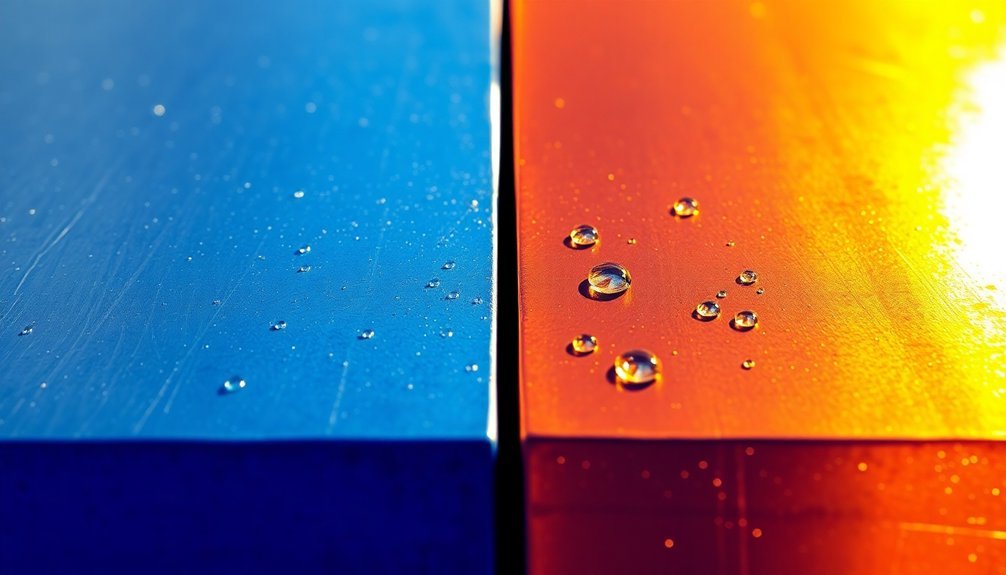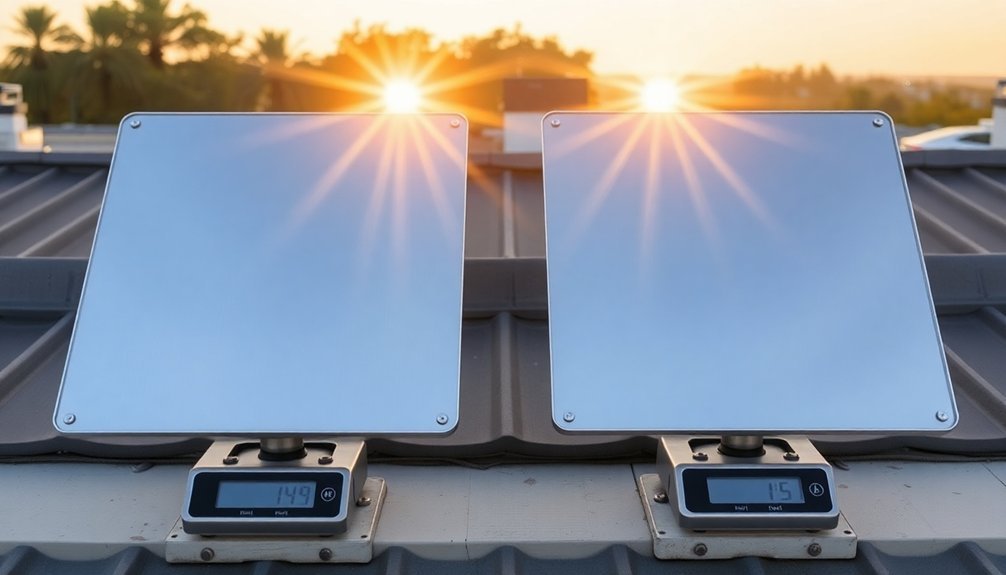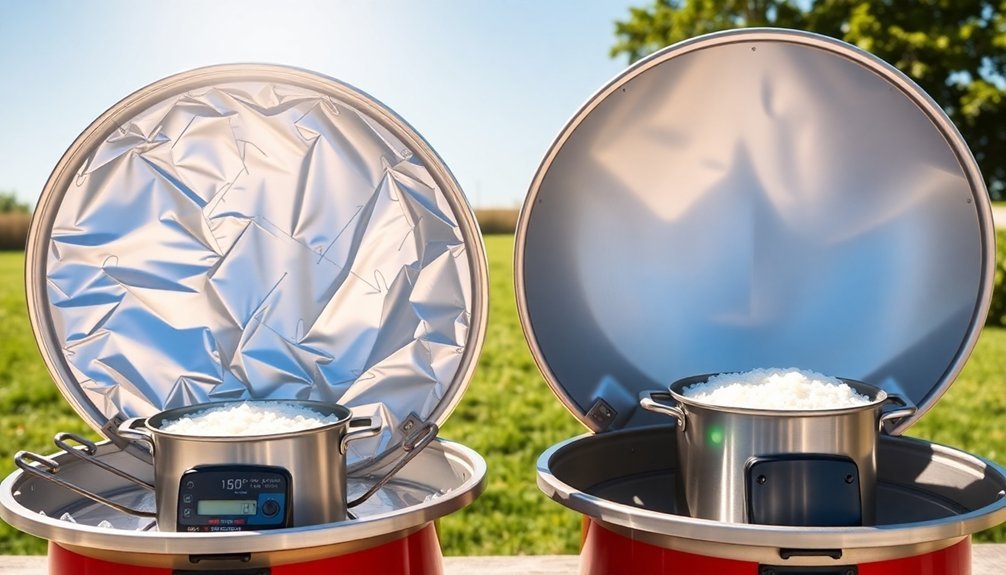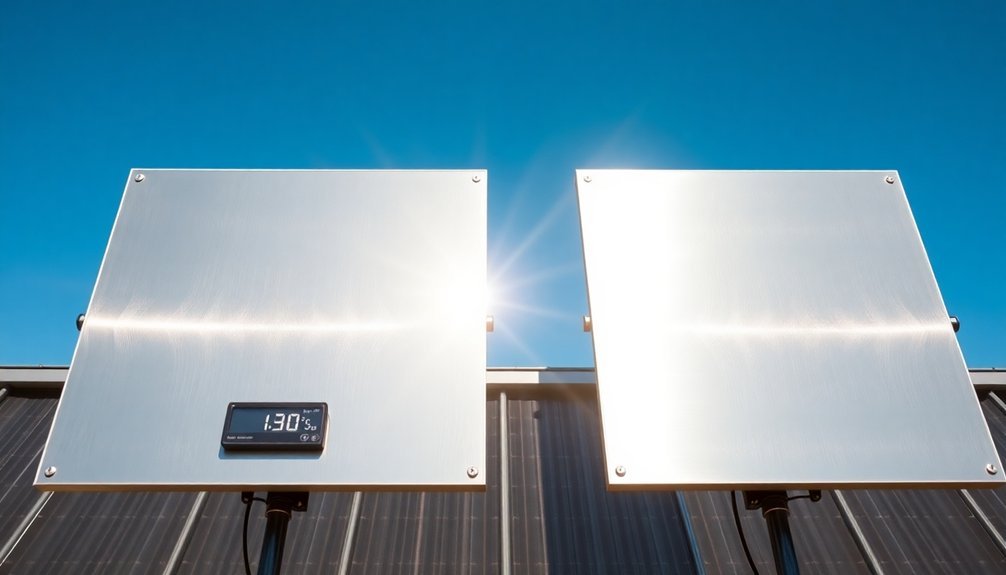Aluminum outperforms steel in heat reflection projects due to its superior atomic structure and reflective properties. You'll find that aluminum reflects up to 97% of radiant heat compared to steel's lower reflection rates. Its face-centered cubic lattice enables exceptional reflectivity, while its lightweight nature makes installation easier and more cost-effective. You can count on aluminum's thermal conductivity (148-255 W/m-K) to far exceed steel's capabilities (21.9-52.0 W/m-K), resulting in better heat management and energy efficiency. Though initial costs may be higher, aluminum's durability, corrosion resistance, and outstanding performance make it the smarter long-term investment. The real-world applications will open your eyes to aluminum's full potential.
Aluminum's Natural Reflection Advantages

While many materials can reflect heat, aluminum's unique atomic structure sets it apart as a superior choice for heat reflection applications. Its face-centered cubic lattice arrangement enables exceptional reflective properties, allowing you to achieve up to 97% radiant heat reflection in your projects.
You'll find aluminum's natural properties particularly advantageous for thermal management. The material's atomic structure facilitates high-efficiency reflection of both sunlight and radiant heat, while its low emissivity makes it an outstanding radiant barrier. The adjacent air space layer helps reduce conductive heat transfer and maintains stable temperatures.
When you're working with polished aluminum surfaces, you can expect excellent reflection of visible and thermal radiation. This makes it ideal for applications where heat management is essential, such as in building materials, where aluminum roofing can reflect up to 95% of incoming sunlight.
Heat Management Performance Results
Because aluminum excels in thermal conductivity compared to steel, you'll achieve superior heat management results across various applications.
You'll find aluminum's thermal conductivity of 148-255 W/m-K considerably outperforms steel's 21.9-52.0 W/m-K, ensuring faster heat dissipation in your projects.
When you use aluminum in heat exchangers or radiators, you'll benefit from its 95% reflectivity and efficient heat transfer properties.
While aluminum's melting point is lower than steel's, it's still perfectly suitable for most temperature control applications.
You'll also spend less time on maintenance, thanks to aluminum's natural oxide layer that prevents corrosion.
In solar applications, you'll see improved energy conversion efficiency when using aluminum reflectors, making it the smarter choice for heat management projects requiring both conductivity and reflectivity.
The 1xxx series alloys provide optimal reflectivity performance for heat reflection applications.
Weight Benefits For Solar Applications

Aluminum's impressive heat management properties are further enhanced by its remarkable lightweight nature.
You'll find it's markedly lighter than steel while maintaining excellent structural integrity, making it perfect for rooftop solar installations where weight reduction is essential.
When you're working on solar projects, you'll appreciate how aluminum's lightweight characteristics simplify installation and transportation.
You won't need as much heavy lifting equipment, and you'll complete projects faster with reduced labor costs.
The material's high strength-to-weight ratio guarantees your installations remain stable against snow loads, rain, and wind impact.
The exceptional strength and malleability of aluminum enables fabrication of custom components for maximum efficiency.
You can count on aluminum's durability too.
It's corrosion-resistant and withstands harsh weather conditions without considerable degradation.
With anodized coatings, your solar installations will maintain their structural integrity throughout their operational lifespan, requiring minimal maintenance.
Cost Versus Performance Analysis
Although the initial investment in aluminum heat reflection systems may seem steep, you'll find the long-term performance benefits often justify these upfront costs.
The material's superior thermal conductivity enables faster heating and cooling responses, leading to reduced energy bills and improved temperature control in your projects. When paired with modern heating systems or renewable energy sources, you'll notice significant operational savings that can offset the higher purchase price. Popular options like 3003 aluminum alloy offer excellent formability while maintaining high thermal efficiency.
- Lower water temperatures needed for the same heat output
- Quicker response to temperature adjustments
- Reduced energy consumption over time
- Better performance in well-insulated spaces
- Enhanced compatibility with renewable energy systems
While aluminum requires specific maintenance considerations, its energy efficiency and rapid heat transfer capabilities make it a smart choice for most heat reflection applications, especially in residential and commercial settings where environmental control is essential.
Real-World Solar Cooking Applications

One of the most practical applications of aluminum's heat reflection properties emerges in solar cooking technology.
You'll find this versatile material in various solar cooker designs, from simple pizza box ovens that reach 200°F to sophisticated parabolic cookers hitting 500°F.
When you're using a basic box cooker, aluminum foil-lined reflectors direct sunlight into the cooking chamber, while panel cookers use similar reflective surfaces to focus heat onto pots inside oven bags.
For maximum efficiency, you'll need to stir your food every 10-15 minutes and reposition your cooker to track the sun.
Though aluminum foil eventually fades with sun exposure, you can upgrade to more durable alternatives like polished aluminum panels or silver reflective tape for longer-lasting performance.
Frequently Asked Questions
How Does Extreme Temperature Cycling Affect Aluminum's Reflective Properties Over Time?
You'll find aluminum maintains impressive reflectivity above 97% during temperature cycling, even at 365°F. Your material's reflective properties won't notably decrease over time, staying above 82% even after multiple thermal cycles.
Can Aluminum Reflectors Be Effectively Repaired if Damaged in Remote Installations?
You can handle minor damage to remote aluminum reflectors through polishing and cleaning, but for severe damage, you'll need to replace the entire unit due to performance requirements and accessibility challenges.
What Maintenance Schedule Is Recommended for Aluminum Reflectors in Desert Environments?
You'll need to inspect your aluminum reflectors every 3 months in desert settings. Schedule cleanings after dust storms, perform corrosion checks monthly, and maintain detailed logs of all maintenance activities and environmental conditions.
Does Salt Spray From Coastal Areas Require Special Protective Coatings?
Yes, you'll need 70% PVDF resin-based coatings to protect your aluminum from coastal salt spray. Anodizing or painting, combined with regular cleaning, is essential to maintain surface integrity and prevent corrosion damage.
How Does Snow Accumulation Impact the Performance of Aluminum Reflective Surfaces?
When snow covers your aluminum surfaces, you'll lose reflectivity benefits since it blocks the metal's reflective properties. You'll also face increased structural stress from added weight and need more frequent maintenance to restore performance.
In Summary
You'll find aluminum is the clear winner for heat reflection projects. Not only does it reflect up to 95% of radiant heat compared to steel's 60%, but you're also getting superior weight savings and easier installation. While the upfront costs may be higher, your long-term benefits in solar cooking and other thermal applications make aluminum the smarter investment. The material's natural properties simply outperform steel in every critical metric.





Leave a Reply